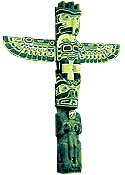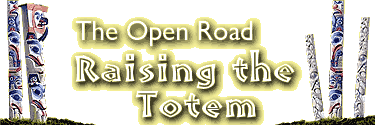 |
 |
 |
|
|||
|
The Open Road: Raising the Totem Day three: Totem Heritage Center, Ketchikan, Alaska. Chips fly from a 500-year-old red cedar lying under a lean-to out of the drizzle. Over a hundred inches of rain fall here each year. The intense green soaks up the misty light. The tree is slowly being transformed into a progression of interconnected, stylized animals. It's slowly becoming a totem pole. Nathan Jackson and his young apprentice studiously carve as a small group of tourists huddle under the tarp. The Totem Heritage Center is dedicated to preserving old totem poles and encouraging native carving. It's hard not to be awestruck, looking at these massive objects up close. They feel almost alive, holy. Yet totem poles are historical monuments rather than religious icons. Master carver Nathan Jackson.

I overhear Nathan's apprentice talking about a totem pole raising happening the day after tomorrow at a remote Haida Indian village. I ask Nathan if tourists can go. He looks at me slyly and says, "If you can get there, you'd be welcome." Day five: early morning. I've just taken off from the choppy waters of Ketchikan Bay in a float plane. I got the last seat on this great old Canadian de Haveland Otter. We pass through a murky bank of fog, until a pristine emerald island appears out of the gray. These planes are so deafening and yet there's a feeling of silence up here as the half dozen passengers stare out their windows. Today, the cargo hold is full of groceries and mail for the villagers. Our pilot tells us, over the float plane's intercom, that he carries everything from corpses to balloons.
We clear one last mountain range and Hydaburg comes into view...about 100 houses scattered near the water's edge. The landing is so smooth, I don't even feel us hit the water. I make my way to the center of the village where I see a crowd gathering.
Most the people here are connected to this place or to each other. There's lots of animated talk. The crowd is 90 percent native, but there are others, even tourists like me. It turns out one guy from my plane is a cop from Seattle. He collects northwest Indian carvings and hopes to buy something. I meet a Canadian who biked, canoed and took ferries all the way from southern British Columbia. He tells me its been over 60 years since a totem was raised here. It's a red letter day in this little outpost. 11 a.m. The totem pole lies on wooden supports. People walk up and down examining every carving mark. The wood is fresh and fragrant -- light colored, no varnish, no paint. An elder comes up and offers a pair of white gloves. I ask what they're for. He tells me they're for those who will carry the pole. My eyes ask, "Is it okay for outsiders?" He holds them out and I take them.
Stan Marsden carved this totem pole and is now arranging us along a series of 4x4's that cradle the huge pole. We could be oarsmen rowing a long canoe. The signal is given and we lift. There's about a hundred of us, carrying the totem pole from where it was set up...to the totem park. Going by the stream that feeds the freshwater of this village.
I find our later the pole weighs 3000 pounds.

We're now on a bluff overlooking the water. It seems the whole village of 400 including all the elders have now arrived.
Esther Nix is the village historian. She wears a black blanket with hand carved abalone buttons that's been in her family over 300 years. She's one of the few left who speaks Haida.
This pole was carved for Esther and all the elders of the village. I'm told the animals in the pole represent the eight clans of this village. Each clan has its origin story and I meet one of the chiefs who tells me the legend of the double-fin killer-whale clan. Years ago a young man set off to sea on a dangerous journey.
I love the way the figures on the pole are intertwined. I learn that the original residents of Hydaburg were rounded up from several villages in 1912 to form a reservation. Because of their varied origins, this has never been a cohesive community. Intertwining the clans together on this pole has particular meaning today.
Stan Marsden carved this pole to thank the elders of Hydaburg for the kindness and support they showed him after the tragic death of his son. Stan hopes this totem will remind the young people of Hydaburg how precious their elders are. His only regret is that the pole was not finished sooner. The town has lost three elders recently.
It's now time to raise the totem, and the drum summons a score of men selected for the task. They grab hold of long thick ropes and tug, while others guide the 36-foot pole, as it slowly rises. A cry rings out and everyone looks proudly on this upright symbol of unity, this artful representation of tradition, this immense log. Someone lights a small bonfire and Esther Nix leads us in a prayer for those elders who are departed. 5 p.m. In a couple of hours the entire village will celebrate with a feast of pickled salmon, venison, smoked sockeye, abalone fried rice and blueberries. I'm invited to stay, but have to catch the last flight back to Ketchikan. Boarding the plane I feel a little sad that I don't come from a people whose identity is tied directly to something like totem poles. Back in Ketchikan, I didn't understand what Nathan Jackson meant when he told me that totems are a way his people identity themselves. I wanted to hear that they have some mystical power. But now I get it. It's a most remarkable thing, really, knowing who you are and where you come from. From the Open Road, I'm Hal Cannon for the Savvy Traveler.
|
 | American Public Media Home | Search | How to Listen ©2004 American Public Media | Terms of Use | Privacy Policy |
